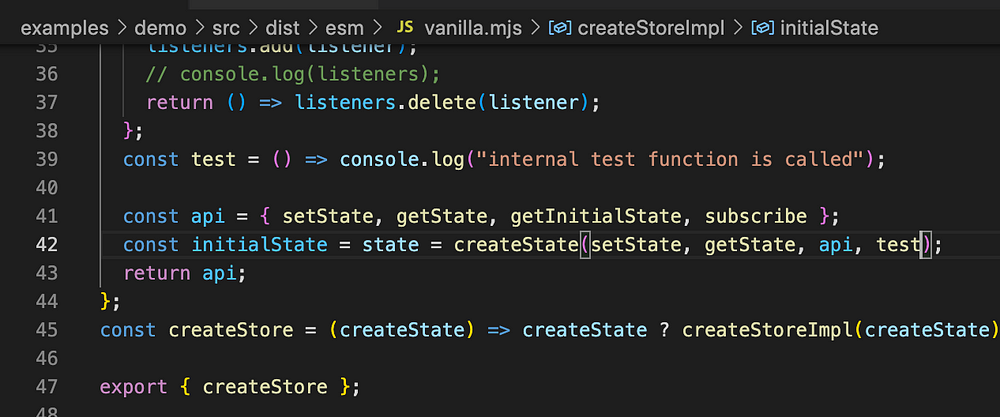createStore in Zustand source code explained.
In this article, we will understand how createStore in Zustand’s source code is written/works.

createStore is exported from vanilla.ts and you will find this at the end of the file.
export const createStore = ((createState) =>
createState ? createStoreImpl(createState) : createStoreImpl) as CreateStore
createStore is arrow function that accepts a parameter called createState. if createState exists, createStoreImpl(createState) is called.
createStoreImpl
const createStoreImpl: CreateStoreImpl = (createState) => {
type TState = ReturnType<typeof createState>
type Listener = (state: TState, prevState: TState) => void
let state: TState
const listeners: Set<Listener> = new Set()
const setState: StoreApi<TState>['setState'] = (partial, replace) => {
// TODO: Remove type assertion once https://github.com/microsoft/TypeScript/issues/37663 is resolved
// https://github.com/microsoft/TypeScript/issues/37663#issuecomment-759728342
const nextState =
typeof partial === 'function'
? (partial as (state: TState) => TState)(state)
: partial
if (!Object.is(nextState, state)) {
const previousState = state
state =
(replace ?? (typeof nextState !== 'object' || nextState === null))
? (nextState as TState)
: Object.assign({}, state, nextState)
listeners.forEach((listener) => listener(state, previousState))
}
}
const getState: StoreApi<TState>['getState'] = () => state
const getInitialState: StoreApi<TState>['getInitialState'] = () =>
initialState
const subscribe: StoreApi<TState>['subscribe'] = (listener) => {
listeners.add(listener)
// Unsubscribe
return () => listeners.delete(listener)
}
const api = { setState, getState, getInitialState, subscribe }
const initialState = (state = createState(setState, getState, api))
return api as any
}
In our previous articles, I have written about how setState, subscribe work. We will cover the remaining functions such as getState, getInitialState, createState.
getState
getState simply returns the state that is declared at the top of this createStoreImpl function.
const getState: StoreApi<TState>['getState'] = () => state
getInitialState
getInitialState returns the initialState.
const getInitialState: StoreApi<TState>['getInitialState'] = () =>
initialState
createState
createState is used to initialise the state variable.
const createStoreImpl: CreateStoreImpl = (createState) => {
createState is a parameter in createStoreImpl. Let’s run some experiments using the demo example provided in the Zustand’s repo.

This is basically just what you pass into “create”
// Create the store using Zustand
const useStore = create((set) => ({
count: 1,
inc: () => set((state) => ({ count: state.count + 1 })),
}));
State initialisation happens in vanilla.ts at L93, even though create is originally exported from React, react.ts internally calls createStore in vanilla.ts.
So how does calling createState initializes the state?
const initialState = (state = createState(setState, getState, api))
The trick lies in calling the arrow function, createState. From the above code snippet, you can see that createState is called with setState, getState, api
Let’s run some experiments with this information. Let’s pass a custom function named test as the parameter without the original parameters.

The above image shows the custom test function I added to demonstrate how the parameters are passed to createState function.
let’s now see this internal test function in action. For us to access this test function, the following example shows how createStore can be initialised with this newly added test parameter.
// Create the store using Zustand
const useStore = create((set, get, api, test) => ({
count: 1,
inc: () => set((state) => ({ count: state.count + 1 })),
test: () => test()
}));
Because we exposed test in vanilla.mjs as shown below, you will have access to this function when you initialise the create function

I am triggering this test function when the button in the demo example is clicked.

This, in turn, calls the test function.
This is some advanced JavaScript arrow functions usage and oh, we also just added a custom test function and used in the demo app. That is cool.
About me:
Hey, my name is Ramu Narasinga. I study large open-source projects and create content about their codebase architecture and best practices, sharing it through articles, videos.
I am open to work on interesting projects. Send me an email at ramu.narasinga@gmail.com
My Github — https://github.com/ramu-narasinga
My website — https://ramunarasinga.com
My Youtube channel — https://www.youtube.com/@thinkthroo
Learning platform — https://thinkthroo.com
Codebase Architecture — https://app.thinkthroo.com/architecture
Best practices — https://app.thinkthroo.com/best-practices
Production-grade projects — https://app.thinkthroo.com/production-grade-projects
